1. Introduction
According to the National Assessment of Academic Ability, elementary and junior high school children in Akita Prefecture consistently maintain higher academic scores than the national average, proving their top-class academic ability. However, in the 1950s, children's academic scores in Akita were significantly lower than the national average. In particular, there was a large gap in children's academic ability between urban and rural areas. About fifty years ago, Einosuke Ito, a well-known writer born in Akita, described Akita's rural villages, "The mountains are beautiful, but the people are poor." Children living in such villages could not receive sufficient education. By 2007, however, children's academic performance had improved across the prefecture, and regional/school gaps were diminished. Currently, the academic standard is guaranteed in every prefectural area, and children/students' academic performance is maintained at the top level in Japan.
Then, why can children in Akita consistently achieve good results in the National Assessment of Academic Ability? The Akita Prefectural Board of Education pointed out in its "Report for the 2021 National Assessment of Academic Ability and Learning Situation" that there were three factors that support children's high academic achievements. First, children acquire ideal daily habits and learning practices. Second, school teachers closely supervise each child and constantly work to improve teaching methods. Third, schools collaborate with families and communities for better ways to raise children. In other words, three areas of education, that is, school education, family education, and social education, are linked with each other to support the development of children's academic performance. Nevertheless, it does not mean that children in Akita suddenly improve their academic ability or concentrate on studying after entering elementary school. There must be other factors giving support to their academic ability. In this regard, the efforts of families and ECEC facilities play an important role in nurturing children's academic ability in their early childhood, which will offer an essential foundation for learning after entering school. This article discusses children's academic ability and preschool education in Akita Prefecture. I will focus on prefectural efforts on preschool education and children's daily habits in early childhood that form their basic lifestyle later.
2. Promoting lifelong learning and preschool education
lAfter the lowest time for children's academic situation in the 1950s in Akita Prefecture, the then-prefectural governor Yujiro Obata pioneered the promotion of lifelong learning. In 1970, he established a lifelong education research team under the supervision of the Akita prefectural government. It was only five years after French educationist Paul Lengrand advocated the concept of lifelong learning at UNESCO in 1965. The book titled "A 50-Year History of Lifelong Learning in Akita Prefecture" (Akita Prefectural Board of Education, 2021) maintained that the then-prefectural governor Obata had a philosophy that the creation of a prosperous Akita "starts and ends with education."Since 1970, Akita Prefecture has been committed to creating an innovative educational culture where people can learn anytime and anywhere through various opportunities in addition to school education. The concept of lifelong learning was included in the administrative policies in 1971. The Lifelong Learning Promotion Division was established in 1972. In addition, the prefectural government strengthened its initiative to comprehensively manage kindergartens and daycare centers to further promote early childhood education, one of the challenging issues in Akita. Today, we naturally talk about the importance of early childhood education and the necessity of integrated operation of two types of childcare facilities, kindergartens and daycare centers. However, for people in the 1970s, to comprehensively manage different types of childcare facilities supervised by different administrative authorities, these must have been epoch-making initiatives focusing on the importance of preschool education.
In addition, during that period, more than 60,000 people in Akita worked away from home every year. Therefore, family education was another focus to make improvements. The prefectural government implemented various communal measures (such as creating parents' and children's associations) to support children's education at home, where their fathers worked outside Akita for six months. Currently, the issues of diversified family structures and children's poverty draw social attention. These issues also require communal support for family education.
In Akita Prefecture, local communities were developed to provide not only "environments of learning for everyone, anytime and anywhere," but also "environments of supporting children's education and families for everyone, anytime and anywhere." Akita was the first prefecture to address such a mission in Japan. Its efforts to provide communal support for children and families were also innovative and vitally necessary for the family situations at that time.
Furthermore, Akita Prefecture designated three pilot areas for promoting lifelong learning in 1971. These areas were Omagari city, Takasu town of Kita Akita city, and Nishime village (the current Nishime town of Yurihonjo city). At that time, Omagari city was committed to improving the education of infants and toddlers, while Takasu town broadly promoted lifelong learning within the community by establishing childcare consulting centers. In addition, Nishime village made prodigious efforts to disseminate adult education, in particular, for women. It is noteworthy that the prefectural government chose these areas that focused on the education of infants/toddlers and mothers (housewives), who played an essential role in children's education at home. According to numerous research studies, parents' involvement significantly affects children's development.
Meanwhile, the Basic Act on Education was revised to include the following new article focusing on collaboration between schools, families, and communities: Article 13 (Partnership and Cooperation among Schools, Families, and Local Residents) "Schools, families, local residents, and other relevant persons are to maintain an awareness of each of their roles and responsibilities regarding education, as well as endeavoring to develop partnerships among themselves and to cooperate with one another." In the case of Akita Prefecture, they had already addressed the education of infants, family education, and the collaboration of schools/families/local communities more than 50 years ago. Therefore, it can be said that the prefecture had forward-looking insights into education.
In 2004, Akita Prefecture integrated the administrative divisions for kindergartens and daycare centers into the Akita Prefectural Board of Education and established the Office for Kindergartens and Daycare Centers. The prefectural government has long been working on the comprehensive education of infants by unifying kindergartens and daycare centers. Finally, in 2006, the Japan's first Centre for Early Childhood Education and Care came into being in Akita. In this way, Akita Prefecture has been committed to promoting preschool education by advocating the concept of lifelong learning and providing opportunities for quality education and childcare for all children anywhere, regardless of whether private or public, or whether kindergartens, daycare centers, or ECEC centers.
In 2018, the national government revised the Courses of Study for Kindergartens, the Childcare Guidelines for Daycare Facilities, and the Childcare Guidelines for Certified Centers for ECEC to align and update their contents. Based on these revisions, today's preschool education is conducted. Therefore, the opportunities for quality education and childcare are provided for all children anywhere across Japan. However, preschool education and facilities are not the sole factors to support children's learning and development. All environments surrounding children influence their learning. In other words, to support children's academic ability, it is necessary to ensure such environments through collaboration between schools, families, and communities. When discussing the high academic performance of children in Akita Prefecture, many researchers have focused on teachers' effectiveness in teaching and instructing children. Akita's unique methods that support children's academic ability are "inquiry-based learning," a form of active learning that inspires children's curiosity and exploration, and "collaborative research," which enhances the capabilities of teachers. These methodologies received a high evaluation (e.g., Abe, 2018; Abe, 2020). However, school education is not the sole factor. The prefectural government's efforts for more than half a century to guarantee not only conventional school education but also "desirable, open, and sufficient education" (Akita Prefectural Board of Education, 2020) for all Akita residents, from babies to the elderly, also support children's academic ability.
Akita Prefecture has been promoting lifelong learning since 1970, the nation's first initiative. However, before that, it seems Akita already had a culture where education was provided for all individuals anytime and anywhere. For example, the prefecture established the Akita Prefectural Library in 1899, earlier than other regions, and introduced Japan's first circulating library system. Under this system, several small libraries were set up in one local community, and a certain amount of books (e.g., 100 books) were rented to these small libraries for several months so that people living nearby these small libraries could read books free of charge (Shindo, 2011). This circulating library system was organized by people belonging to elementary schools or youth associations. Therefore, local communities have been deeply involved in the educational development of residents. In this way, local communities in Akita Prefecture have played an essential role in education for a long time. In addition, the prefectural government actively promoted lifelong learning, providing opportunities for quality education for not only school children but also all individuals. I assume all these factors support the high academic performance of children in Akita Prefecture.
In this section, I have introduced the administrative efforts of Akita Prefecture in promoting lifelong learning and preschool education, which is the supporting factor for children's academic ability. In the next section, I will discuss children's daily lives at home in Akita, particularly young children's daily habits, which is another factor relating to their academic ability.
3. Children's daily habits: Do children in Akita go to bed early, wake up early, and eat breakfast?
(1) Daily habits of children in Akita PrefectureOne factor that supports the high academic performance of children in Akita is said to be the stable educational power of families, including parents' support. In 2015, the Akita Prefectural Board of Education published the "Seven Rules of Nurture for Akita's Wakasugi." The term "Wakasugi" here means children, who bear the responsibility for Akita's future. These rules aim to realize ideal educational environments, including student-focused classrooms, learning habits at home, educational capabilities of families and local communities, and other characteristics unique to Akita Prefecture. For example, the first rule requires children to "go to bed and wake early, eat breakfast; maintain a daily schedule." In addition, the Akita Prefectural Board of Education created the "Ten Rules of Learning for Akita's Wakasugi Children" in 2008.
These rules were created based on the items extracted from the National Assessment of Academic Ability, in which Akita school children showed higher scores than the national average. The first rule here also requires children to "go to bed and wake early, eat breakfast, study at home." This rule reflected the survey items of "Go to bed before 10 pm," "Wake up before 7 am," "Eat breakfast every day," and "Study (prepare for) school lessons at home." Children in Akita showed higher scores than the national average particularly in these survey items. According to the board, the first rule indicates that children in Akita maintain regular daily habits and study hard at home (Akita Prefectural Board of Education, 2008).
As you can see, children in Akita seem to have good daily habits, "go to bed and wake up early, eat breakfast every day." However, such daily habits cannot be acquired immediately after they enter elementary school. I assume that children's basic lifestyle is formed through daily habits in their early childhood. Then, does the first rule of "go to bed and wake up early, eat breakfast every day" represent the actual status of their daily habits? To answer this question, I conducted a comparative survey on the daily habits of preschool children living in the central part of Akita Prefecture and those living in the Kanto region (Tokyo and Chiba Prefecture). I will explain the results and findings below.
(2) Wake-up time and bedtime of children in Akita Prefecture compared with the Kanto region (Tokyo and Chiba Prefecture)I conducted a questionnaire survey targeting 553 mothers with children of four to six years old (Akita Prefecture: 202; Kanto region: 351). Survey items include children's and mothers' wake-up time, bedtime, and daily meal patterns, all of which constitute daily habits in early childhood. For subject children in Akita, 79 children attended kindergartens, and 123 attended daycare centers/certified ECEC centers. For subject children in the Kanto region, 250 children attended kindergartens, and 101 attended daycare centers.
Figure 1 shows the wake-up time of children in Akita Prefecture and those in the Kanto region. The results show that 48.2% of children in Akita and 22.8% in Kanto wake up before 6:30 am, indicating that more children in Akita wake up early in the morning. In addition, according to the "5th Survey on Children's Everyday Life" conducted by the Benesse Education Research and Development Institute in 2016, 28.9% of children answered that they woke up before 6:30 am. This result also suggests that children in Akita wake up relatively early in the morning compared to children in other regions.
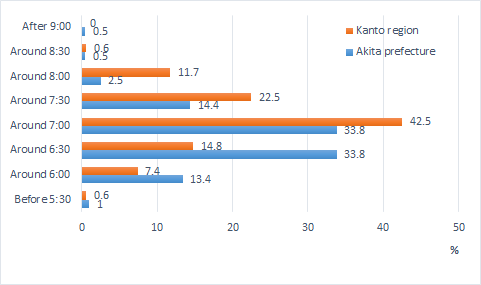 Figure 1: Wake-up time of children in Akita Prefecture compared with the Kanto region (%)
Figure 1: Wake-up time of children in Akita Prefecture compared with the Kanto region (%)Next, I compared children's bedtime in Akita Prefecture and the Kanto region. Figure 2 shows that 26.3% of children in Akita and 19.4% in Kanto go to bed after 22:00. Therefore, one in every four children in Akita and one in every five children in Kanto stay up late after 22:00. Meanwhile, in the survey given by the Benesse Education Research and Development Institute, 24.9% of children answered they would go to bed after 22:00. Therefore, children in Akita stay up relatively late at night.
Based on the above survey results, it is confirmed that children in Akita wake up early in the morning but stay up relatively late at night.
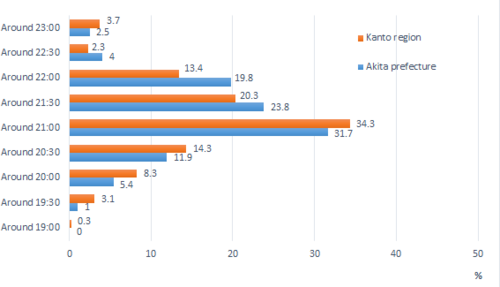 Figure 2: Bedtime of children in Akita Prefecture compared with the Kanto region (%)
Figure 2: Bedtime of children in Akita Prefecture compared with the Kanto region (%)(3) Wake-up time and bedtime of mothers in Akita Prefecture compared with the Kanto region
Next, I will explain the survey results regarding the daily habits of mothers who assume elementary responsibility for raising children. Table 1 shows the occupation of mothers under the survey. It indicates that 30.7% of mothers in Akita and 21.4% in Kanto work full-time. Therefore, approximately one in every three mothers in Akita and one in every five in Kanto are full-time employees in this survey.
| Akita Pref. | Kanto region | |
|---|---|---|
| Full-time worker | 62 (30.7%) | 75 (21.4%) |
| Part-time worker | 73 (36.1%) | 45 (12.8%) |
| Contracted employee | 9 (4.5%) | 9 (2.6%) |
| Working at home | 1 (0.5%) | 6 (1.7%) |
| Employer | 2 (1%) | 3 (0.9%) |
| Self-employed | 7 (3.5%) | 25 (7.1%) |
| Agriculture, forestry, and fisheries | 1 (0.5%) | 2 (6%) |
| Housewife | 40 (19.8%) | 178 (50.7%) |
| Other / No response | 7 (3.5%) | 8 (2.3%) |
| Total | 202 | 351 |
Figure 3 shows the wake-up time of mothers in Akita Prefecture and those in the Kanto region. The results show that 73.7% of mothers in Akita and 54% in Kanto wake up before 6:00 am, indicating that more mothers in Akita wake up early in the morning. According to the 2020 survey conducted by the NHK Broadcasting Culture Research Institute, about 35% of mothers in their 30s and about 50% of mothers in their 40s answered that they wake up at around 6:00 am. Compared with the results of the NHK survey, more mothers with young children in Akita wake up early in the morning.
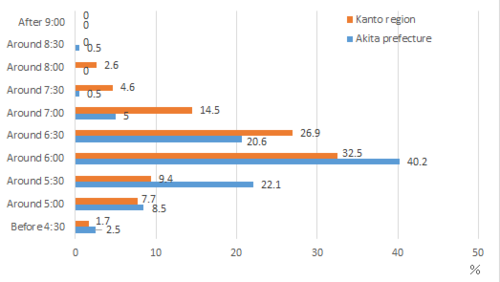 Figure 3: Wake-up time of mothers in Akita Prefecture compared with the Kanto region (%)
Figure 3: Wake-up time of mothers in Akita Prefecture compared with the Kanto region (%)Next, I will compare the bedtime of mothers in Akita Prefecture and those in the Kanto region. Figure 4 shows that 71.8% of mothers in Akita and 58% in Kanto go to bed by around 23:00, indicating that more mothers in Akita go to bed early at night. Meanwhile, the 2020 survey by the NHK Broadcasting Culture Research Institute revealed that about 50% of mothers in their 30s and 40% of mothers in their 40s go to bed by around 23:00. Compared with the NHK survey results, it is evident that mothers with young children in Akita go to bed relatively early.
Based on the above results regarding the wake-up time and bedtime of mothers, it is confirmed that mothers with young children in Akita Prefecture wake up early in the morning and go to bed early at night.
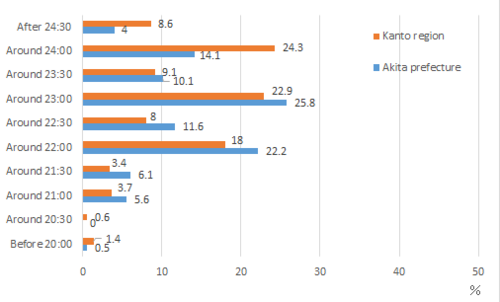 Figure 4: Bedtime of mothers in Akita Prefecture compared with the Kanto region (%)
Figure 4: Bedtime of mothers in Akita Prefecture compared with the Kanto region (%)(4) Family meal habits of children in Akita Prefecture compared with the Kanto region
Today, the importance of "eating together with someone" is evaluated highly. The government recommends in its Fourth Dietary Education Promotion Plan having meals with children (at breakfast and dinner) as often as possible. In particular, having meals with someone is very important for children in their early childhood period that will form their basic lifestyle later. For example, it is reported that having meals with adults instead of eating alone or with siblings is beneficial for children because they can learn proper table manners and cultural customs from adults. Furthermore, having meals with adults will help children maintain a proper daily rhythm and good eating habits (e.g., Ainuki, Ichikawa, & Akamatsu, 2011; Senoo, 2020). However, in reality, do young children eat meals together with adults?
Tables 2 and 3 show children's family meal habits at breakfast and dinner, respectively. The survey results show that 74.5% of children in Akita and 50.1% in Kanto eat breakfast with their parents, while 99% of children in Akita and 86.2% in Kanto eat dinner with their parents. Therefore, it is confirmed that more children in Akita eat meals with their parents than those in Kanto, indicating that children in Akita spend relatively longer hours with their parents.
| Akita Pref. | Kanto region | |
|---|---|---|
| Eat breakfast with parents | 149 (74.5) |
175 (50.1) |
| Eat breakfast alone or with siblings | 51 (25.5) |
174 (49.9) |
| Total | 200 | 349 |
| Note: The upper figure represents the number of children, while the lower figure in parentheses represents the percentage of children.Non-response data is excluded from the parameter. | ||
| Akita Pref. | Kanto region | |
|---|---|---|
| Eat dinner with parents | 200 (99) |
301 (86.2) |
| Eat dinner alone or with siblings | 2 (1.0) |
48 (13.8) |
| Total | 202 | 349 |
| Note: The upper figure represents the number of children, while the lower figure in parentheses represents the percentage of children.Non-response data is excluded from the parameter. | ||
(5) Children in Akita go to bed late and wake up early?
Based on the above results, it is summarized that subject children in Akita Prefecture wake up earlier in the morning and go to bed later at night than those in the Kanto region, while subject mothers in Akita Prefecture wake up and go to bed earlier than those in the Kanto region. In addition, more children in Akita Prefecture eat meals with their parents than those in the Kanto region. According to previous research studies, children who get up early in the morning tend to eat breakfast early, thus having enough time to digest a meal slowly and maintaining regular bathroom habits (Shinohara, Nagano, & Horiuchi, 2021). In addition, eating meals with parents help children maintain a proper daily rhythm (Eda, 2006). Considering these benefits, waking up early in the morning and eating meals with parents seem to contribute to forming children's ideal daily habits in their early childhood.
As this survey did not cover all regions across Japan, we cannot generalize the results as national trends. Nevertheless, we can assume that more children in Akita Prefecture spend longer hours with parents at home than those in the Kanto region. In addition, more children in the Kanto region tend to have meals alone or with siblings, thus separating children's time and adults' time. One factor supporting children's higher-than-average academic performance in Akita is said to be their ideal daily habits. However, the survey results did not prove that children in Akita wake up and go to bed early, but confirmed that they spend more time with adults at home while securing children's time. It is also confirmed that more children in Akita eat meals with parents at breakfast and dinner, maintaining good family meal habits. According to the results of questionnaire surveys conducted by the National Institute for Educational Research in 2007 and 2019, more children, who used to eat breakfast daily and spend sufficient time for conversations with family members, maintained a higher rate of correct answers. In addition, it is said that children's "social capital," which produces enriched interpersonal and trustful relationships, significantly affects their academic performance (Hamada, 2022). Considering the above factors, it seems that children in Akita Prefecture maintain high academic ability partly due to the foundation of their daily lives nurtured through enriched family interactions.
4. Summary
In this article, I discussed preschool education in Akita Prefecture from the perspectives of children's preschool activities and basic lifestyles at home. Akita's schools have been highly acclaimed for their teaching methodology that closely supervises each student. Therefore, many people from various places in Japan visited these schools to experience the Akita-style teaching methodology. While teachers' excellence in teaching and instructing is one direct factor that enhances children's academic performance, effective preschool education also seems to contribute to their academic ability. As you see, early childhood education and care are said to be the foundation of enriching children's life. Such preschool education cannot be achieved instantly. I assume that one of the contributors is Akita's long-standing educational culture, where all local residents support children's education.
Akita Prefecture started Japan's first circulating library system in 1902, which was organized by local communities. Thus, local communities have long been contributing to improving the educational prowess of Akita's people. In 1965, Akita Prefecture promoted lifelong learning under the strong leadership of the then prefectural governor Yujiro Obata. In 1972, the prefectural government took initiatives to strengthen the collaboration of kindergartens and daycare centers and actively encourage the education of women who primarily assume responsibility for taking care of children and their education at home. Obata wrote in his book titled "Lifelong Learning Policy in Akita Prefecture" (1978) that early childhood education was one reason he recognized the necessity of lifelong learning. He insisted on the importance of the enhancement of education for both young children and their parents in order to promote early childhood education.
He established additional kindergartens and daycare centers to enhance preschool education. He also designated a research facility to seek solutions for the comprehensive management of kindergartens and daycare centers to the extent permitted under the existing law. He compiled these initiatives as a collection of case studies and introduced them to related parties (Akita Prefectural Lifelong Learning Promotion Division, 1980). For example, he served as director for the Omagari City Omagari Minami Kindergarten and the Omagari Central Daycare Center, which were both located on the same premises. He made these two facilities jointly conduct events and lunchtime as often as possible, allowing children to have the same activities and experiences. In this way, he promoted equal education regardless of the types of childcare facilities. At that time, for administrative purposes, kindergartens were under the control of the Ministry of Education, and daycare centers were under the control of the Health and Welfare Ministry. Even in Akita Prefecture, kindergartens were supervised by the prefectural board of education and daycare centers by the prefectural civil affairs division. Under such circumstances, Obata served as director of both a kindergarten and a daycare center and provided opportunities for these children to join the same activities to the greatest extent possible. In this regard, he made epoch-making initiatives. In addition, he integrated the Iidagawa Daycare Center and the Wakatake Kindergarten, both of which were municipal childcare facilities. He changed the name to "Iidagawa Town Wakatake Early Childhood Education Center" in 1973. Under this unified childcare facility, a childcare curriculum was prepared for children aged two to three years based on the government's Childcare Guidelines for Nursery Schools and for children aged four to five years, based on the Course of Study for Kindergartens. The facility employed teachers who acquired both the qualifications as kindergarten teacher and daycare center caregivers.
Meanwhile, Act on Certified Children Centers was revised through the "Comprehensive Support System for Children and Child-rearing" started in 2015. Under the revised act, a certified children center (with the functions of a kindergarten and daycare center) should be established as "a single facility with the legal status of schools and child welfare institutions." The act also requires employing ECEC teachers who qualified as both kindergarten teachers and daycare center caregivers. In this regard, the Wakatake Early Childhood Education Center was also an epoch-making initiative, as it employed such qualified ECEC teachers more than 40 years before the Act on Certified Children Centers was revised.
Obata had an educational philosophy that education should start with newborn babies, so he insisted that it is essential to promote the education of mothers of infants first (1978). For example, by referring to the "Pelikan Letter" in western Germany, he sent birthday cards to mothers of newborn babies. He attached a reply-paid postcard, writing tips for childrearing so that mothers could consult him about their babies using this postcard. He also conducted guidance tours for childrearing consultations. He also sent the "Suginoko News Letter" to parents with children aged zero to four, providing materials for infant education. He also appeared in the TV program "Suginoko Hiroba" to provide detailed examples and suggestions for childrearing, such as the characteristics and tendencies of children's behavior patterns (mainly for children aged three).
As I have discussed above, Akita Prefecture has been consistently working on the promotion of preschool education to provide opportunities to receive quality education and childcare for all children. Their efforts include comprehensively managing preschool education environments with the support of schools, families, and local communities. I believe that the children's high academic performance resulted from such efforts. Furthermore, besides building up regular daily habits through the rules of "wake up and go to bed early, eat breakfast" at home, children's lifestyle valuing time spent with family members and time spent on their own also contributed to children's high academic performance.
-
References:
- Tomomi Ainuki, Misa Ichikawa, & Rie Akamatsu. (2011). Association of Preschool Children's Family Breakfast Habits with Their Lifestyles and Their Families' Childcare Practices. The Japanese Journal of Nutrition and Dietetics, 69,304⁻311.
- Akita Prefectural Board of Education. (2008). The Ten Rules of Learning for Akita's Wakasugi Children.
https://www.pref.akita.lg.jp/pages/archive/6620 (Last viewed on April 20, 2022) - Akita Prefectural Board of Education(2015).The Seven Rules of Nurture for Akita's Wakasugi. https://www.pref.akita.lg.jp/pages/archive/8526 (Last viewed on April 20, 2022)
- Akita Prefectural Board of Education. (2021).Results of 2021 Survey on National Academic Ability and Learning Situation.
https://www.pref.akita.lg.jp/pages/archive/9914 (Last viewed on April 28, 2022) - Akita Prefectural Board of Education. (2021).A 50-Year History of Lifelong Learning in Akita Prefecture. Lifelong Learning Division.
https://www.pref.akita.lg.jp/pages/archive/56148 (Last viewed on April 28, 2022) - Akita Prefectural Lifelong Learning Promotion Division. (1980). A 10-Year History of Lifelong Learning in Akita Prefecture. Office of Akita Prefectural Lifelong Learning Promotion Division.
- Noboru Abe. (2018). Quality Inquiry-based Education and Teachers' Collaborative Research Support Top Level Academic Achievements. Sogo Kyoiku Gijutsu. November. ed., 48-51.
- Noboru Abe. (2020). Achieving "Deep Learning" with Inquiry-based Education by clarifying goals and objectives and enhancing research on educational materials. Sogo Kyoiku Gijutsu. April. ed., 48-51.
- Benesse Education Research and Development Institute. (2016). Survey on Children's Everyday Life V.
https://berd.benesse.jp/up_images/research/YOJI_all_P01_65.pdf (Last viewed on June 2, 2022)
Survey report in English https://www.childresearch.net/data/ec/2020_02.html - Setsuko Eda. (2006). Association of Young Children's Family Breakfast Habits with Their Daily Habits and Health. The Journal of Child Health, 65,55-61
- Makoto Hamada. (2022). Teachers' Capabilities with Families and Communities as Social Capital. EN-ICHI FORUM, 377, 16-19.
- National Institute for Educational Policy Research. (2019). 2019 Survey Report on National Academic Ability and Learning Situation.
https://www.nier.go.jp/19chousakekkahoukoku/report/question/ (Last viewed on May 5, 2022) - National Institute for Educational Policy Research(2007).Points of 2007 Survey Results on National Academic Ability and Learning Situation.
https://www.nier.go.jp/tyousakekka/tyousakekka_point.pdf (Last viewed on May 5, 2022) - NHK Broadcasting Culture Research Institute. (2020). Do you sleep longer or shorter than the average?
https://www.nhk.or.jp/bunken/yoron-jikan/column/sleep-2020.html (Last viewed on April 28, 2022) - Ministry of Agriculture, Forestry and Fisheries of Japan. (2021).The Fourth Dietary Education Promotion Plan.
https://www.maff.go.jp/j/press/syouan/hyoji/attach/pdf/210331_35-6.pdf (Last viewed on April 28, 2022) - Tomoko Senoo, (2020). Youji no shokuji no igirikai no hattatsukatei [Developmental processes in understanding the perception of eating behaviors in preschool children]. Kazama Shobo.
- Yusuke Shindo. (2011). Books Go Round: The Introduction and Diffusion of the Bookmobile in the 1900s - 1910s. Research Paper at the Japan Mass Communication Association 2011 Spring Workshop, 1-6.
- Toshiaki Shinohara, Kohei Nagano, & Ryosuke Horiuchi. (2021). Lifestyle Characteristics Among Preschoolers by Wake-up Time : A Case Study of Nursery School Children in Arakawa Ward, Tokyo. Tokyo Future University bulletin, 15,69-77.
- Yujiro Obata. (1978). Lifelong Learning Policy in Akita Prefecture. All Japan Social Education Association.



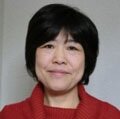 Tomoko Senoo
Tomoko Senoo










